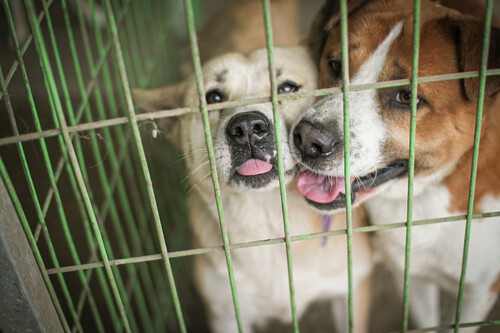In January 2024, a significant change occurred in South Korea regarding a traditional dish that has been part of the nation’s culture for centuries: dog meat. The country passed a ban on the consumption of dog meat, making it punishable by up to three years in prison.
This ban has created a pressing issue: what to do with half a million dogs.
The ban. The national ban on dog meat consumption was enacted in 2024 and is set to be fully implemented by February 2027. According to the BBC, it has left thousands of farmers in a state of uncertainty and despair. For generations, raising dogs for meat had been a legitimate source of income and, for some, an honorable vocation.
South Korea’s decision to outlaw the sale of dog meat in 2024 marks a significant cultural turning point, ending a culinary tradition that included dishes such as bosintang, a soup once valued for its supposed health benefits.
500,000 dogs. Reverend Joo Yeong-bong is a religious leader and president of the Korean Edible Dog Association. He describes the situation as unsustainable. Traders are disappearing, debts are accumulating, and farmers are losing their means of livelihood.
Additionally, The Times reported that many farmers own hundreds of dogs that they can’t sell, complicating or rendering impossible the relocation of these animals. The South Korean government has offered compensation of up to $440 per dog to those who agree to close their farms before the deadline. However, many view this measure as insufficient and poorly structured, especially given that nearly 500,000 animals remain in captivity.
An ethical and political storm. The apparent victory of the animal rights movement has revealed a troubling paradox. Dogs saved from the slaughterhouse could still face euthanasia due to a lack of alternatives. Most of these animals are large breeds selected for their weight and commercial value. Still, they’re often deemed unsuitable for adoption in an urbanized society where small apartments are the norm.
Additionally, many of these dogs are Tosa Inu or Tosa Inu mixes, which are classified as dangerous and are subject to strict regulations. To complicate matters further, shelters are already saturated, and there’s a shortage of logistical resources. There’s also a social stigma attached to dogs bred for consumption.
Although the government insists that euthanasia isn’t part of the plan, even leaders of animal welfare organizations have admitted that many dogs will end up being put down. Activists like Lee Sangkyung from Humane World for Animals Korea argue that neither the government nor civil organizations were adequately prepared to handle the consequences of their own success.

Partial solutions. Some isolated cases, such as the rescue of 200 dogs in Asan city and their subsequent shipment to Canada and the U.S., demonstrate that international adoption can offer a limited escape route.
The BBC highlighted testimonies from individuals like former grenadier Yang Jong-tae. He underwent an emotional transformation upon witnessing how rescuers treated the dogs with the same human dignity. Despite his continued opposition to the ban, this experience profoundly affected him. For him, as for many in his profession, dog meat is no more morally objectionable than beef or pork.
Experts like Chun Myung-Sun emphasize that consuming dog meat poses greater health risks because it’s not part of the country’s regulated meat system. While dog meat is still consumed in countries such as China, Vietnam, and parts of Africa, it has become increasingly taboo in South Korea. In 2024, only 8% of citizens reported having tried dog meat in the past year, down from 27% in 2015. Since the announcement of the ban, more than 600 of the country’s 1,537 dog farms have closed.
Poverty risk. While cultural progress is often accompanied by positive changes, it also has painful social costs. According to The Times, many older breeders have accepted a future of poverty. They believe that having survived times of hunger and war, they can manage without an income. In stark contrast, younger individuals in the sector face a much bleaker reality. They’re deeply in debt, have no buyers for their dogs, unclear job prospects, and feel trapped in an activity that’s now deemed illegal.
Chan-woo is a 33-year-old farmer who owns 600 dogs and has invested all his capital in this enterprise. His story illustrates the helplessness experienced by many in the community. Neither the government nor animal rights organizations have provided them with effective solutions. What began as a fight for animal compassion now risks evolving into an unnoticed humanitarian crisis.
The invisible cost. The South Korean government spends around $4.3 million annually to expand shelters and support private facilities. However, it still lacks a comprehensive plan for managing the growing number of dogs. While animal advocates have relocated thousands of dogs since 2015, they caution that their resources are currently unable to accommodate the ongoing influx.
Farmers are calling for an extension of the compliance grace period for the new laws. However, some worry that even this may not be enough. Joo has warned that if a sustainable solution isn’t found for the fate of both the dogs and the humans affected by this forced transition, the consequences by 2027 could be tragic.
The ban on dog meat in South Korea may represent a moral achievement for many. However, it also reveals the complex ethical, economic, and social dilemmas that emerge following the implementation of these kinds of laws.
Related | South Korea Recycles 97% of Its Food Waste. The Key: Either Pay to Recycle or Get Fined




View 0 comments